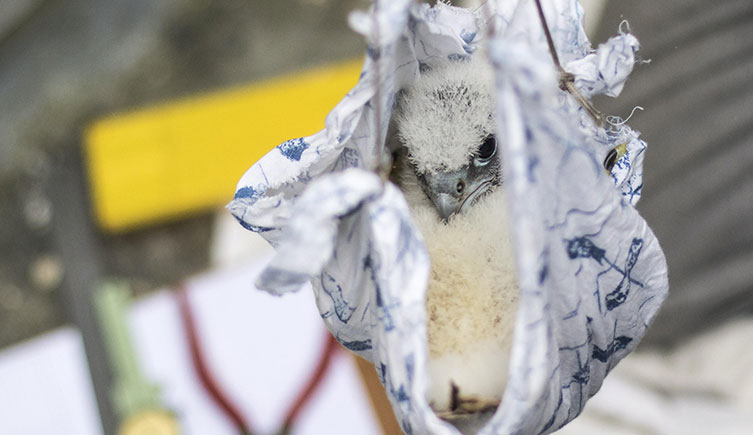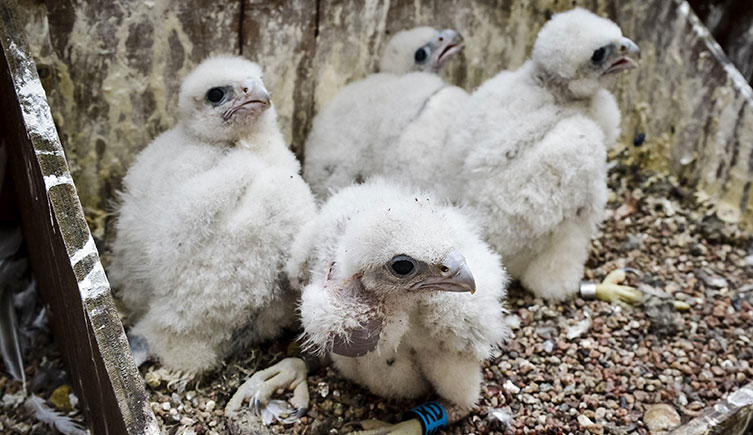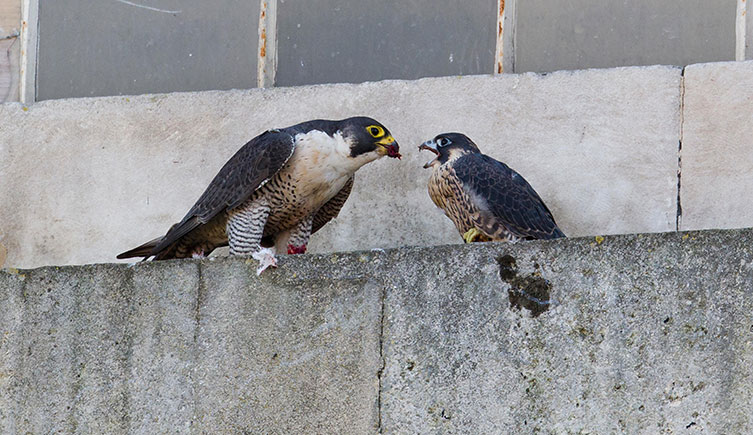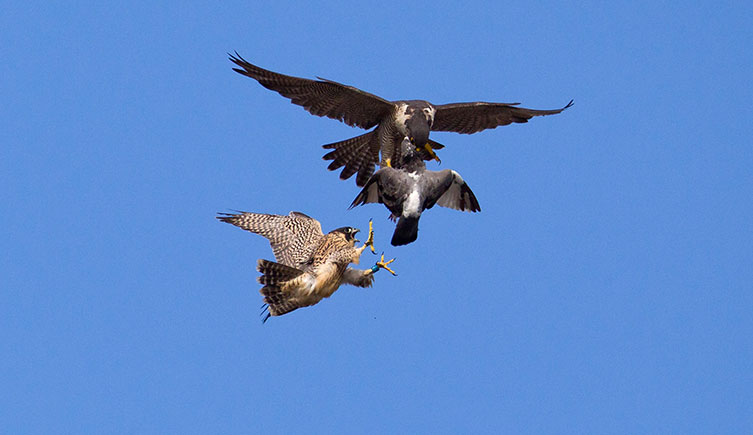Create a list of articles to read later. You will be able to access your list from any article in Discover.
You don't have any saved articles.

Peregrine falcons (Falco peregrinus) have adapted to urban living. These birds of prey are successfully nesting and raising chicks high above town and city crowds in the UK and elsewhere around the world. © Gavin Rowley/ Alamy Stock Photo
High up in the city, watching from the spires and skyscrapers, the world's fastest birds are looking for a meal and raising their young.
Peregrine falcons (Falco peregrinus) are famously capable of reaching speeds of around 320 kilometres per hour as they dive or 'stoop' to catch their prey. Traditionally, the birds kept away from humans, but they've been getting closer in the last few decades.
'Peregrines began moving into our cities during the 1990s after their populations recovered from decades of decline from persecution and the effects of pesticides in the countryside,' explains naturalist and author Ed Drewitt, who is currently researching peregrine falcons for a PhD at the University of Bristol.
A total of 1,769 breeding pairs were estimated across the UK by the British Trust for Ornithology's (BTO) peregrine survey in 2014 (see the PDF). The survey found that peregrine falcons were faring much better in urban and coastal situations than in the hills. Food supply is one factor that attracts the predators to the lowlands, while in the uplands there is continued persecution by humans, particularly around grouse moors.
'Peregrines nest on over 200 urban or manmade locations across the country today,' says Ed. 'The earliest record of a peregrine using a building goes back to 1864/65 at Salisbury Cathedral, while in London peregrines used St Paul's Cathedral as early as 1921.'

Flying over London, a peregrine falcon passes St Paul's Cathedral. There are records of the birds nesting there as far back as 1921. © David Tipling Photo Library/ Alamy Stock Photo
You might not see much similarity between cliff ledges and bridges, pylons or power stations - all locations where the birds of prey choose to nest - but as the peregrine falcon population increased, so did competition for traditional nest sites. Oblivious of their intended human purposes, the birds simply sought out structures that balanced shelter and access to a good supply of food.
Where there's plenty of a particular type of prey, predators will become specialists in hunting it. Peregrine falcons share their traditional craggy homes with rock doves (Columba livia), familiar to most of us as the feral pigeons so common in our towns and cities. They're the same birds, just with different names depending on where they live.
'Rock doves and peregrines have evolved alongside each other,' explains Hein van Grouw, Senior Curator of the Museum's Bird group. 'Both are built for fast flying. Each has a bulky, muscular body with strong, pointed wings and a relatively short tail.'

Birds are the main staple of a peregrine falcon's diet. Pigeons are their favourite prey, but they will also hunt a range of other species depending on availability, particularly starlings, blackbirds and collared doves, usually catching them in flight. © Nathan Guttridge/ Alamy Stock Photo
As someone who keeps domesticated or 'fancy' pigeons, Hein knows all about protecting his pets from these powerful predators and does not fly his birds freely.
'Peregrines hunt by searching for prey either from a very high perch or from a great height in the air, and then stoop down at high-speed to hit their prey,' he explains.
'They strike their prey with a clenched foot, stunning or killing it with the impact, then turn to catch it in mid-air. If they miss the initial strike, peregrines will chase their prey in a pursuing flight.
'Peregrines are naturally partially nocturnal hunters, especially during migration season as their prey often migrates at night, so they easily adapt to city life as the lights give them good visibility.'

The fastest animals in the world, peregrine falcons reach phenomenal speeds as they dive through the air in pursuit of prey, often plummeting out of the sky from a great height. During a full-speed stoop, the falcon folds its wings to reduce drag. One was even recorded for the Guinness World Records in 2005 travelling at more than 380 kilometres per hour while stooping. © Jerome Murray - CC/ Alamy Stock Photo
Ed Drewitt is most familiar with the peregrines of Bristol, which are perfectly at home in the rocky Avon Gorge west of the city centre. He says, 'I remember hearing the whoosh of a peregrine as it cut through the still air overhead. The bird sped across the gorge like a fighter jet and caught a pigeon totally by surprise.
'It was quickly killed and hidden in a hidey hole known as a cache.
'While peregrines often glide overhead no faster than a swift or duck, the moment they choose to make a stoop dive their body forms the perfect shape for dropping through the air like a bullet towards its unsuspecting prey.
'It is amazing to witness how fast and agile these birds can be in flight.'

A juvenile peregrine falcon perched on a cliff along Avon Gorge in Bristol, high above the traffic © Nature Picture Library/ Alamy Stock Photo
While peregrine falcons sensibly nest out of sight at the top of buildings, several of their nests can be secretly watched via webcams. Ed, who has studied the diet of urban peregrines in depth, lists these virtual views in his top encounters with the birds.
He says, 'Some of my favourite memories are via web cameras, especially watching peregrines bringing in prey at night. They hunt migrating birds such as woodcock, moorhens and teal during the cover of darkness, helped by street lamps which light up their prey.
'It provides an insight into their behaviour that was unknown until relatively recently.'
One of the best-established peregrine webcams is installed at Nottingham Trent University's Newton building, where staff first collaborated with the Nottinghamshire Wildlife Trust to secure the nest of a pair of peregrine falcons 20 years ago. At first, a camera was used just for security monitoring, but in 2012 the footage was livestreamed online. It has been popular ever since.

Peregrines return every year to nest on a Nottingham Trent University building. A webcam streams live footage, allowing viewers worldwide to follow the trials and tribulations of the birds as they breed and raise chicks. © Jack Perks/ Alamy Stock Photo
Norwich and Bath cathedrals both have peregrine webcams too thanks to the Hawk and Owl Trust's peregrine project, while in Chester the public are encouraged to join a Peregrine Watch every June to help monitor the pair that nest on the historic lead shot tower. The country's first urban peregrine nesting spot at Salisbury Cathedral is still in use and available to watch online, as are high-rise nests in Wakefield, Brighton, Sheffield, Leamington Spa, Woking and many other towns and cities around the country (a list of peregrine webcams is provided at the end of this article).
Late spring to early summer is the best time of year to tune into a webcam, when you can follow the birds through their breeding season, watch them raise chicks and see those chicks leave the nest.
Peregrine falcons might not mate for life in the conventional sense, but birds will return to successful nest sites year after year and consequently form the same pairs. Competition for the best spots can be fierce - even between generations of the same family.
Peregrines start exhibiting courtship behaviour from February when the male displays and calls from a nest ledge to attract a female (and deter rivals), before performing demanding aerial routines to prove his fitness. If the female is suitably impressed, the pair will move on to gentle mutual displays including bowing, preening and calling soft 'peeps'.
The nest, known as an eyrie, is just a shallow scrape in loose gravel or soil, formed by either of the pair using their feet and chest. In the countryside, it would be on an inaccessible cliff or quarry ledge. In towns and cities, a variety of structures from churches to factories have been adopted as alternatives. In some sites where ledges are deemed too narrow - with a chance of tragic tumbles for eggs or chicks - concerned bird-lovers and wildlife organisations have installed artificial nest boxes so the birds can safely create a scrape.

Peregrine falcons have been breeding at Chichester Cathedral since 2001 and have raised more than 60 chicks, including the one pictured which is about to be ringed by a licensed handler. © WENN Rights Ltd/ Alamy Stock Photo

In the tower at Salisbury Cathedral, licensed handlers place a small, uniquely marked ring around a peregrine chick's leg. Ringing allows us to learn about bird movements, breeding, feeding and lifespans. © PA Images/ Alamy Stock Photo

When four peregrine falcon chicks hatched at Salisbury Cathedral in 2015, it was only the second time since 1953. But peregrines have successfully fledged there nearly every year since. © PA Images/ Alamy Stock Photo

Baby peregrine falcons are fed regular meals of bird meat by both their mum and dad. Peregrines usually lay between two and five eggs, with three to four being the norm. But only 60% of chicks survive their first year. © blickwinkel/ Alamy Stock Photo

Two young peregrine falcons on a church tower ledge in Chorley, Lancashire. With brown- and cream-coloured feathers and a blue-grey beak, juvenile peregrines look quite different to the adult birds. © Gavin Rowley/ Alamy Stock Photo

Perched on a derelict building in Bristol, a young peregrine falcon is brought food by its parent. The juvenile has a more heavily patterned bib area and a blueish eye ring and beak, in contrast to the adult's yellow ones. © Nature Picture Library/ Alamy Stock Photo

An adult peregrine passes a pigeon to his offspring in mid-air as part of teaching the youngster to hunt © Nature Picture Library/ Alamy Stock Photo
Mating takes place frequently to reinforce the pair bond as well as for procreation. Once fertilised, three to four eggs are laid over a fortnight from late March. After the last egg is laid, the female does most of the incubation, though the male will provide 'nest relief' and sit on the eggs so she can hunt. Chicks hatch out around a month later.
The young birds are white and fluffy, in contrast to the steely grey feathers of their parents. But with a steady diet of bird-meat meals delivered by mum and dad, in just five weeks the chicks rapidly develop the brown and cream colours of juvenile birds.
Once their flight feathers have developed, peregrine falcon fledglings will begin to venture out from the nest to learn and practice vital hunting skills.
A lot can go wrong in the first year of a peregrine falcon's life, from broken eggs to fledging failures, and the BTO estimates that just 60% survive this phase. Those birds that do make it will reach maturity at two years old and begin their own search for territories to start breeding. Peregrine falcons live for seven years on average in the wild but the oldest known reached 21 years.
According to Ed, male peregrines generally stay close to where they fledged, while females will move much further away, often several hundred miles. It's in their interest to settle in a city - a study published in 2019 found that urban peregrines have better breeding success than those in the countryside, apparently due to the availability of prey.

Peregrine falcons were first spotted at Norwich Cathedral in 2009 and have been returning there ever since. Towns and cities provide plenty of prey and potential nest sites, encouraging the birds to stick around and breed. © Nature Picture Library/ Alamy Stock Photo
As many as 30 breeding pairs of peregrine falcons now live in the UK's capital, according to the London Wildlife Trust. It's the second-highest urban peregrine falcon population in the world, after New York.
Tate Modern and the Houses of Parliament are both good places to catch a glimpse of the birds. A pair also nested on one of Battersea Power Station's chimneys and developers went to great expense to relocate the birds, which have since successfully raised chicks on a purpose-built tower on the site.

Two peregrine falcon chicks in a nest on a London high-rise. Tall buildings with undisturbed ledges provide suitable urban alternatives to the inaccessible cliff and quarry sites peregrines use in the countryside. Peregrines also sometimes nest on structures such as bridges and pylons. © Nature Picture Library/ Alamy Stock Photo
Unique behaviour to watch for in London includes peregrine falcons hunting ring-necked parakeets. The predators have developed a taste for the introduced parakeets, which roost in large groups around the capital. Florin Feneru, Identification and Advisory Officer at the Museum, says the exotic green birds can make up to a third of a young peregrine's prey in June, when inexperienced parakeets learning to fly make an easy target for adult peregrines with mouths to feed.
Provided they are undisturbed by humans, and there's plenty on the menu, peregrine falcons should continue to thrive in our urban environments. And with the help of a few webcams, we can watch them prosper.

An adult female peregrine soars above Hammersmith in London © Nature Picture Library/ Alamy Stock Photo
Webcams may be switched off outside of the March to July breeding season, or earlier if no eggs hatch.
... or that it helped you learn something new. Now we're wondering if you can help us.
Every year, more people are reading our articles to learn about the challenges facing the natural world. Our future depends on nature, but we are not doing enough to protect our life support system.
British wildlife is under threat. The animals and plants that make our island unique are facing a fight to survive. Hedgehog habitats are disappearing, porpoises are choking on plastic and ancient woodlands are being paved over.
But if we don't look after nature, nature can't look after us. We must act on scientific evidence, we must act together, and we must act now.
Despite the mounting pressures, hope is not lost. Museum scientists are working hard to understand and fight against the threats facing British wildlife.
For many, the Museum is a place that inspires learning, gives purpose and provides hope. People tell us they 'still get shivers walking through the front door', and thank us for inspiring the next generation of scientists.
To reverse the damage we've done and protect the future, we need the knowledge that comes from scientific discovery. Understanding and protecting life on our planet is the greatest scientific challenge of our age. And you can help.
We are a charity and we rely on your support. No matter the size, every gift to the Museum is critical to our 300 scientists' work in understanding and protecting the natural world.
From as little as £2, you can help us to find new ways to protect nature. Thank you.